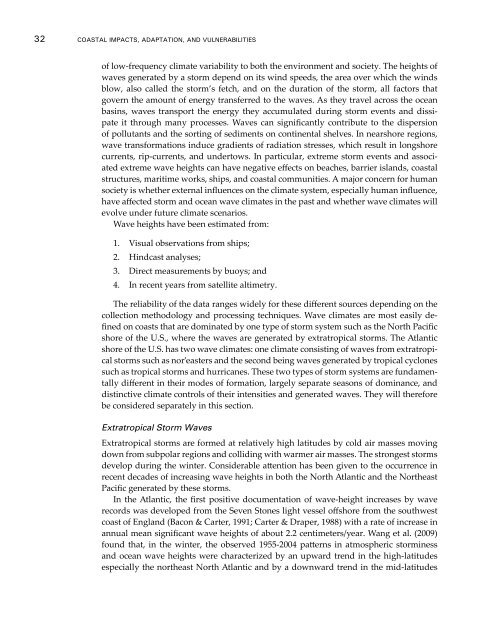Coastal Impacts, Adaptation, and Vulnerabilities - Climate ...
Coastal Impacts, Adaptation, and Vulnerabilities - Climate ...
Coastal Impacts, Adaptation, and Vulnerabilities - Climate ...
Create successful ePaper yourself
Turn your PDF publications into a flip-book with our unique Google optimized e-Paper software.
32 <strong>Coastal</strong> <strong>Impacts</strong>, <strong>Adaptation</strong>, <strong>and</strong> <strong>Vulnerabilities</strong>of low-frequency climate variability to both the environment <strong>and</strong> society. The heights ofwaves generated by a storm depend on its wind speeds, the area over which the windsblow, also called the storm’s fetch, <strong>and</strong> on the duration of the storm, all factors thatgovern the amount of energy transferred to the waves. As they travel across the oceanbasins, waves transport the energy they accumulated during storm events <strong>and</strong> dissipateit through many processes. Waves can significantly contribute to the dispersionof pollutants <strong>and</strong> the sorting of sediments on continental shelves. In nearshore regions,wave transformations induce gradients of radiation stresses, which result in longshorecurrents, rip-currents, <strong>and</strong> undertows. In particular, extreme storm events <strong>and</strong> associatedextreme wave heights can have negative effects on beaches, barrier isl<strong>and</strong>s, coastalstructures, maritime works, ships, <strong>and</strong> coastal communities. A major concern for humansociety is whether external influences on the climate system, especially human influence,have affected storm <strong>and</strong> ocean wave climates in the past <strong>and</strong> whether wave climates willevolve under future climate scenarios.Wave heights have been estimated from:1. Visual observations from ships;2. Hindcast analyses;3. Direct measurements by buoys; <strong>and</strong>4. In recent years from satellite altimetry.The reliability of the data ranges widely for these different sources depending on thecollection methodology <strong>and</strong> processing techniques. Wave climates are most easily definedon coasts that are dominated by one type of storm system such as the North Pacificshore of the U.S., where the waves are generated by extratropical storms. The Atlanticshore of the U.S. has two wave climates: one climate consisting of waves from extratropicalstorms such as nor’easters <strong>and</strong> the second being waves generated by tropical cyclonessuch as tropical storms <strong>and</strong> hurricanes. These two types of storm systems are fundamentallydifferent in their modes of formation, largely separate seasons of dominance, <strong>and</strong>distinctive climate controls of their intensities <strong>and</strong> generated waves. They will thereforebe considered separately in this section.Extratropical Storm WavesExtratropical storms are formed at relatively high latitudes by cold air masses movingdown from subpolar regions <strong>and</strong> colliding with warmer air masses. The strongest stormsdevelop during the winter. Considerable attention has been given to the occurrence inrecent decades of increasing wave heights in both the North Atlantic <strong>and</strong> the NortheastPacific generated by these storms.In the Atlantic, the first positive documentation of wave-height increases by waverecords was developed from the Seven Stones light vessel offshore from the southwestcoast of Engl<strong>and</strong> (Bacon & Carter, 1991; Carter & Draper, 1988) with a rate of increase inannual mean significant wave heights of about 2.2 centimeters/year. Wang et al. (2009)found that, in the winter, the observed 1955-2004 patterns in atmospheric storminess<strong>and</strong> ocean wave heights were characterized by an upward trend in the high-latitudesespecially the northeast North Atlantic <strong>and</strong> by a downward trend in the mid-latitudes
















